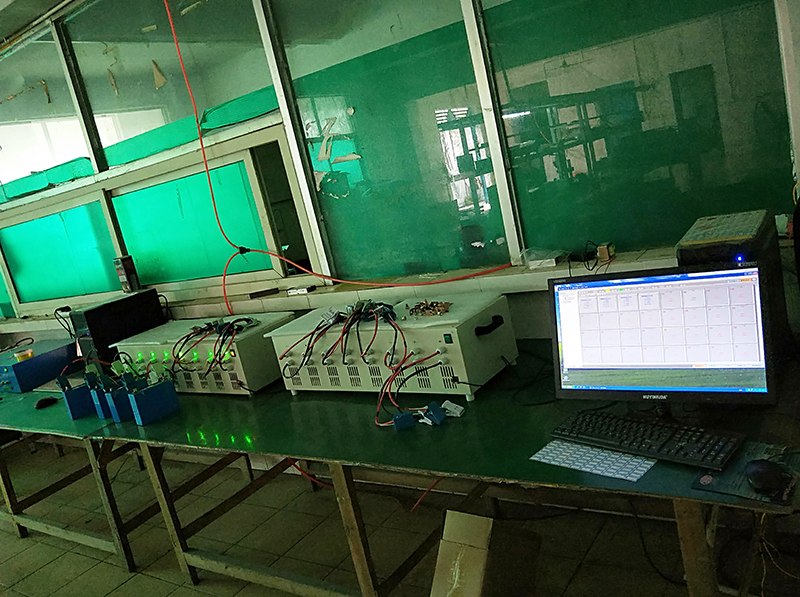Shenzhen Dazheng Weiye Electronic Technology Co., Ltd.
Contact: Zhan Zhenyu
Mobile: 13632978018
QQ: 1605140880, 416126808
Contact: Chen Yaye
Mobile: 13547713087
QQ: 472009640
Website: www.dzwydz.com
Website: en.dzwydz.com
Address: 4th Floor, Building 19, Area C, Nanlian Fangxing Technology Park, Longgang District, Shenzhen
The cycle of charge and discharge of the forklift lithium battery is the process in which lithium ions move back and forth between positive and negative electrode materials through electrolyte. In the cycle of forklift lithium battery, in addition to the REDOX reaction at the positive and negative poles, there are a lot of side reactions. If the side effects of the forklift lithium battery can be reduced to a low level and lithium ions can always flow smoothly between the positive and negative electrode materials through the electrolyte, the cycle life of the forklift lithium battery can be increased.
The movement of lithium ions from the positive pole to the negative pole must pass through the SEI film covering the carbon negative pole. The study on aging and decay of battery materials is relatively early, especially on SEI film. The main research method is to analyze the stability and decay mechanism of battery materials through the experimental data of battery life combined with electrochemical characterization methods [6].
The stability of SEI film has important influence on the stability of battery. The SEI film is unstable and easy to precipitate lithium metal, which will lead to the rapid decay of the cathode active material. The lithium battery formed by the SEI film can be stored at high temperature for more than 4 years. D. Aurbach et al. analyzed the positive and negative electrode plates of the lithium cobalt oxide battery after disassembled and cycling through SEM, XRD and other experiments, and attributed the capacity decline mainly to the irreversible side reactions of the continuous consumption of Li+ by the SEI film of the negative pole and the LiF interface film formed by the LiCoO2 and HF film of the positive pole. P. r. amadass et al. established the capacity decay model by describing the process of lithium ion loss caused by the continuous growth of negative SEI film in the charging and discharging cycle. S. ankarasubramanian et al. [10] established a capacity decay model including the diffusion of solvents and the growth mechanism of SEI film, and concluded that the capacity decay presented a linear relationship with SEI film thickness and battery aging time.
The results show that the discharge capacity of the battery decreases gradually, and the internal resistance and thickness increase gradually. The results show that after 200 cycles, many cracks appear on the anode surface, and the average particle size decreases. The negative electrode indicates thickening of the SEI film and precipitation of lithium and lithium compounds at the end of the cycle. The release and embedding of lithium ions will cause the internal stress of the crystal lattice. Under the action of this internal stress fatigue, LiCoO2 forms cracks and the final particle size decreases.
J. Vetter, etc. [12] the aging mechanism of material inside the battery with the charging and discharging cycle carried on the thorough analysis, the stability of the crystalline structure of the electrode materials were reviewed, and active materials and electrolyte interface factors such as side effects and adhesive performance will have an effect on the battery capacity and power performance, across the electrodes and the aging of cause and effect are summarized. For anode materials, in addition to due to the formation of SEI film, poor growth, make the contact between the anode component result in higher impedance of the factors, the main factors are: solvent embedded C produce gas cause C particles break, loop changes in volume of the active material particles contact between the precipitation variation, lithium metal react with the electrolyte to accelerated aging and so on.
Common electrolyte components are solvents, lithium salts and various additives. Anode and cathode materials always interact with the electrolyte in the process of removing and intercalating lithium ions. Complex REDOX reactions may occur on the interface due to this interaction, and even produce gas or solid products, which will lead to electrolyte loss. The gas will increase the internal pressure of the battery and lead to the deformation of the battery. The solid products will form a passivation film on the surface of the electrode, which will increase the polarization of the battery and reduce the output voltage of the battery. All of these factors have adverse effects on battery capacity and safety, and ultimately on battery cycle life. The addition of additives, such as anisole, a trace additive in EC/DEC solvent system, can effectively improve the cycling performance of lithium ion batteries.
The nature of the positive and negative collector also affects the battery capacity and cycle life. Aluminum and copper are commonly used as fluid collecting materials for positive and negative poles of forklift lithium battery, both of which are easily corroded metal materials. When the collector fluid is corroded, passivation film, poor adhesion, local corrosion (pitting corrosion) and overall corrosion will increase the internal resistance of the battery, resulting in loss of capacity and lower discharge efficiency. The adhesion and corrosion resistance can be enhanced by acid - base etching, conductive coating and other pretreatment methods.


 | Contact:Zhan Zong Fangxing Technology Park, Longgang District, Shenzhen |
